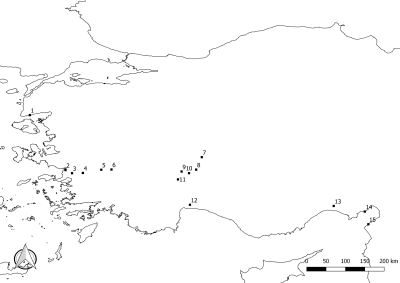
Cite this as: Willet, R. 2018 Early Imperial Tableware in Roman Asia Minor: a perspective on the diachronic patterns and morphological developments, Internet Archaeology 50. https://doi.org/10.11141/ia.50.17
Asia Minor forms a fascinating region in the Early Roman Empire as it emerged from centuries of geopolitical conflicts of warring Hellenistic dynasts and troubles of the late Roman Republic. Furthermore, parts of this area were already heavily urbanised before Roman incursions and it seems that during the first three centuries CE the number of towns and cities increased (Marek 2010, 515). Culturally speaking, Asia Minor constituted a complex tapestry of influences of Persian, Anatolian, Greek and Roman elements; Francis Haverfield (1915, 12) already recognised that the concept of Romanisation is inadequate to describe the Anatolian situation. The polis, often considered a typically (Classical) Greek institution, had its greatest apogee in the Hellenistic and Imperial periods (Van Nijf 2013, 311; Zuiderhoek 2014, 107-8). Indeed, the cultural and economic pluriformity observed in this region and the interplay of (inter)regional similarities and local diversity fits recent discourses on globalisation in the Roman world (Pitts and Versluys 2015, 7-14). Presenting a set of paradigms rather than a unified model, globalisation focuses on the effects of processes by which localities and people become increasingly interconnected and interdependent. Globalisation does not lead to a convergent and homogenised singular culture alone, but to greater local heterogeneity as well. Asia Minor was part of large imperial hegemonies from the Achaemenids and the subsequent Hellenistic kingdoms before becoming part of the Roman Republic and Empire. Yet, as will be demonstrated using tableware, this did not lead to a homogenisation of material culture. Instead, the resulting patterns of tableware at different places throughout Asia Minor show a complex interplay of similarities and differences in the shapes of vessels consumed.

The usage of tableware in Asia Minor pre-dates the Roman Empire by centuries, particularly the red-slipped tableware that became popular and widely distributed and consumed from the late second century BCE in the form of Eastern Sigillata A–ESA. This was probably produced in the area of northern Syria or Cilicia, and likely was an important influence on later Italian terra sigillata production (Malfitana et al. 2005). Later, production of red-slipped tableware on a large scale would develop on the western coast of Asia Minor from the latter half of the first century BCE in the Maeander Valley (Eastern Sigillata B-ESB) and the area around Phokaia and Pergamon (Eastern Sigillata C–ESC) (Hayes 1985). Production of tableware has been identified on a local/regional level as well, such as at Sagalassos in Pisidia, where an array of workshops dedicated to producing tableware (Sagalassos Red Slip Ware - SRSW) became active from Augustan times onwards (Poblome 1999). With multiple producers and an increased urban population, it becomes an interesting question how this affected patterns of tableware consumption in Asia Minor. Did producers follow one uniform fashion or is there local or regional diversity? How is this reflected in consumption patterns? To answer these questions, this article will discuss the production of tableware at Sagalassos and compare this to the consumption pattern of tableware at the cities of Ephesos, Assos and Tarsos (Figure 1).
Ideally, several contexts that are closed and preferably of primary deposition would be used to study the development and spread of tableware in Asia Minor, but unfortunately such contexts are rare. To compensate for this lacuna, this article will use large sets of data derived from a multitude of excavated contexts to approach tableware trends in terms of morphology and consumption. Two sources of data are used. The first is the Sagalassos Red Slip Ware (SRSW) derived from excavations conducted at Sagalassos since 1989. The enormous quantities of pottery recovered have not been fully quantified, as the number of sherds reaches millions (Willet and Poblome 2011, 108). A sample of 84 contexts yielding 53,695 typologically identified vessels is used. This sample reflects the total period of production of SRSW, from the late first century BCE to the late seventh/early eighth century CE, although the focus throughout this article will lie on the Early/Mid-Imperial period, here roughly defined as the late first century BCE to the third century CE.
The second data source is the Inventory of Crafts and Trade in the Roman East database (ICRATES). The ICRATES project, originally conceived by Jeroen Poblome and built up by Philip Bes, tried to create an exhaustive database of published tableware in the Roman East. The main body of data was compiled from 2006 to 2012, with data continuing to be updated by entering further minor publications. Currently 352 publications are incorporated, recording 33,587 vessels of Roman tableware from 487 sites in the Roman East (Bes and Poblome 2008; Willet 2012, 9). Of these, only 25 sites are located within Asia Minor, however, as this is a region with a relative paucity of publications. Still, 4800 vessels are recorded for these 25 sites. Here it must be noted that, for the other regions, published data from intensive field-survey projects, which have a tendency to yield many sites, are also incorporated. For Asia Minor, intensive survey has not been a prevailing method to date, which is reflected in the low number of published tableware items derived from surface survey. Until recently archaeological projects in Turkey dealing with antiquity have focused primarily on large monumental sites and on architectural, epigraphical and other 'classical' remains. This focus continues to some extent, but the situation is changing. Many new and advanced projects have been started and other 'veteran' projects are now implementing new theories and inter-/multidisciplinary methodologies. For pottery studies, while the old state of affairs is still reflected in many publications an increasing number of good pottery studies are being published for Asia Minor (e.g. Japp 2009a; 2009b; Armstrong 2012; Jackson et al. 2012; Autret et al. 2015). For the sake of comparison, individual cities, rather than contexts, have been chosen as the basic unit of analysis throughout this article, specifically Sagalassos, Ephesos, Assos and Tarsos. For Sagalassos, a substantial set of data is available to the author for analysis, while for the latter three sites a large number of vessels are recorded in the ICRATES database.
Many researchers have used diachronic data distribution methods to visualise data chronologically (e.g. Fentress and Perkins 1988, 207-8). The basic idea is to obtain a graphically represented curve that shows the deposition of a material category over time. Such a curve is created by applying a Gaussian data distribution method (see Willet 2014 for details; also Millett 1987; Willis 2004). These curves display the variation of the tableware consumption over time. To observe the evolution of the most common forms consumed, one should focus on the peaks in these curves. Peaks in the curve represent periods of higher distribution of tableware. The forms (mostly) responsible for forming these peaks reveal, in essence, waves of innovation in tableware or the continuity of certain forms. Using this approach, trends in tableware of early Imperial Asia Minor can be mapped with less than perfect data.
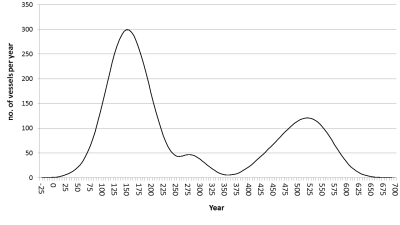
Sagalassos is located in Pisidia, 90km from modern Antalya. At a height of 1490-1600m above sea level, the site is dominated by mount Akdağ (2276m) and the territory of some 1200km² is distinguished by mountains and valleys. From 6 BCE onwards, the Via Sebaste connected Sagalassos to the coastal plain of Pamphylia to the south and to the Roman Pisidian colonies, notably Antiochia in Pisidia and interior Anatolia in the north (Levick 1967, 39). The city, which has its roots in the fifth/fourth century BCE, started to flourish from Hellenistic times and Hellenistic pottery production is attested by kilns underneath the Augustan odeion (Waelkens and Poblome 2011, 78). Although regional traditions of tableware production existed in Hellenistic times, this evolved into the production of Sagalassos Red Slip Ware in the eastern suburbia of the site in early Imperial times, where several workshops and 18 kilns have been excavated. Furthermore, magnetometry survey has uncovered some 136 anomalies caused by thermoremnant magnetisation that have all been interpreted as possible kilns (Enden et al. 2014, 93; Willet and Poblome 2015, 142; Claeys 2016, 311). Tableware production continued into the seventh century and recent estimates on the output and local demand seem to suggest that the production was, in all likelihood, aimed at regional markets beyond the direct hinterland. This is confirmed by recent observations at the neighbouring ancient cities of Prostanna, Malos and Seleukia Sidera (B. Hürmüzlü and F. Özcan, pers. comm., Ankara, April 2015). SRSW has been encountered farther away as well, such as at the Pamphylian city of Perge.
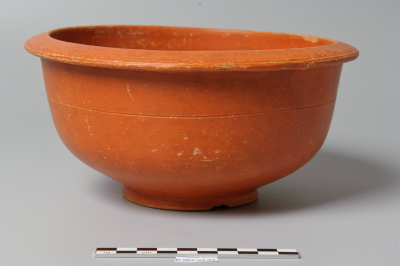
For the analysis of the SRSW, the typology and chronology (with minor alterations) as developed by Jeroen Poblome (1999) are used. When Gaussian (Figure 2) diachronic data distributions are applied to the dataset of SRSW, the earliest noticeable peak is present in the second century CE with a small second peak in the third. The curve shows a distinct drop in the fourth century, with recovery in the fifth and sixth centuries. A distinct rise in the deposition, and thereby consumption and production, of SRSW in the first two centuries CE would fit a more general pattern of prosperity observed in Asia Minor, as evidenced by, for example, building activity and relative peace. The later second and third century witnessed increasing political instability that plagued the empire. Yet Pamphylia and Pisidia may have fared well by playing a more important role in supplying the army, which sustained the regional economy (Mitchell 1999, 432-33; Poblome 2006, 201-7). In the rural settlement pattern in the territory of Sagalassos, no decline is discernable for the third century, although both SRSW curves show a decline in deposition in this period (Poblome 2015, 105).
| SRSW form | count (percentage of total) | general shape | dating of form |
|---|---|---|---|
| 1C100 | 6265 (11.7%) | Dish | 25 BCE-CE 350 |
| 1F150-1 | 4670 (8.7%) | Container | 25 BCE-CE 350 |
| 1B170 | 4044 (7.5%) | Bowl | 25 BCE-CE 300 |
| 1B190-1 | 3762 (7.0%) | Bowl | CE 1-350 |
| 1B130 | 3214 (6.0%) | Bowl | CE 300-700 |
| 1B220-1 | 3170 (5.9%) | Bowl | CE 300-700 |
| 1B150 | 3013 (5.6%) | Bowl | 25 BCE-CE 300 |
| 1A100 | 2416 (4.5%) | Cup | 25 BCE-CE 300 |
| 1B160-3 | 2131 (4.0%) | Bowl | CE 1-300 |
| 1B230-3 | 1863 (3.5%) | Bowl | CE 400-700 |
| Total | 34,548 (64.3%) |
If the morphology of the vessels during the first three centuries CE is taken into consideration, the most numerous forms are dish 1C100, container 1F150-1 (Figure 3), bowl 1B170, bowl 1B190-1, small bowl 1B150, cup 1A100 and bowl 1B160-3 (Table 1). It is also noteworthy that for the seven centuries of SRSW production, the ten most common forms (n=34,548) make up 64 per cent of the total Sagalassos dataset.
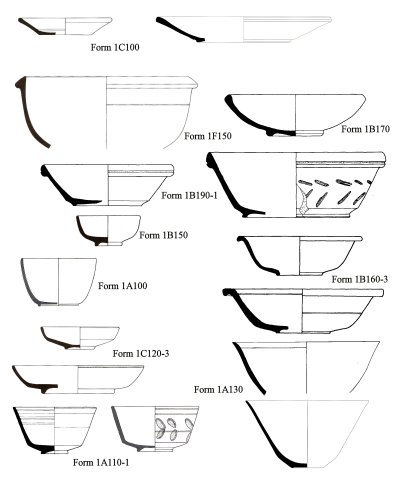
| forms | count | general shape | lower date | upper date | forms | count | general shape | lower date | upper date |
|---|---|---|---|---|---|---|---|---|---|
| second century CE | third century CE | ||||||||
| 1C100 | 6265 | Dish | 25 BCE | CE 350 | 1C160-1 | 976 | Dish | ||
| 1F150-1 | 4670 | Container | 25 BCE | CE 350 | 1B100-1 | 1636 | Bowl | CE 200 | CE 400 |
| 1B170 | 4044 | Bowl | 25 BCE | CE 300 | 1C100 | 6265 | Dish | 25 BCE | CE 350 |
| 1B190-1 | 3762 | Bowl | CE 1 | CE 350 | 1B190-1 | 3762 | Bowl | CE 1 | CE 350 |
| 1B150 | 3013 | Bowl | 25 BCE | CE 300 | 1F150-1 | 4670 | Container | 25 BCE | CE 350 |
| 1B160-3 | 2131 | Bowl | CE 1 | CE 300 | 1A160-1 | 1058 | Cup | CE 1 | CE 350 |
| 1A100 | 2416 | Cup | 25 BCE | CE 300 | 1B171 | 91 | Bowl | CE 200 | CE 450 |
| 1C120-3 | 1165 | Dish | CE 1 | CE 300 | 1C170-1 | 615 | Dish | 25 BCE | CE 350 |
| 1A130 | 1161 | Cup | 25 BCE | CE 300 | 1B260 | 243 | Bowl | CE 1 | CE 350 |
| 1A110-1 | 781 | Cup | CE 1 | CE 300 | 1B170 | 4044 | Bowl | 25 | BCE CE 300 |
Since the data distribution methodology uses dating-range and frequency per form to shape the curve, the forms with a high frequency play a role in the Gaussian peaks of the second and third century as well (Figure 4 and Figure 5, Table 2). However, changes can be discerned, as becomes clear if the peaks from the Gaussian curve at CE 150 and CE 280 are considered. Especially noteworthy is the disappearance of small bowl 1B150 and cup 1A100 in the fourth century, both previously numerically popular forms, but the mastos cup 1A130 (n=1,161; Figure 6), which is morphologically akin to late Hellenistic drinking cups, also ceases to play an important role in the third century. Later forms, such as the 1C160-1 (n=976) and 1B100-1 (n=1636) appear in the third century, while forms with a broader date-range, such as the 1A160-1 (c. 1-350 CE, n=1058) remain more prevalent owing to the Gaussian plotting at the expense of those with a shorter range, e.g. 1A110-1 (c. 1-300 CE, n=781). Naturally this makes clear that distributing the data as such is creating an artefact, but one that does derive from the contextual studies creating the typo-chronology and takes quantity and time into account proportionally. The next step is to compare these diachronic developments of inland Sagalassos, a city where tableware was produced and consumed, to the wider network of cities in Asia Minor.

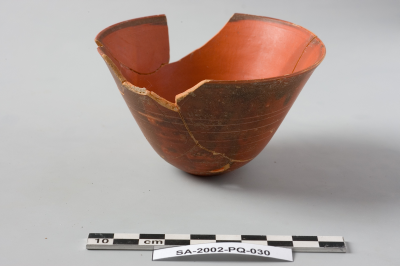
The three cities of Assos, Ephesos and Tarsos have been selected to study wider regional patterns of tableware consumption in Asia Minor. The three cities have a large number of vessels recorded in the ICRATES database and here a specific focus will be made on five major ware-groups, Eastern Sigillata A (ESA), Eastern Sigillata B (ESB), Eastern Sigillata C (ESC), Eastern Sigillata D (ESD) and Italian terra sigillata (ITS). Although the three former wares have already been mentioned, ESD was probably produced in south-west Asia Minor or western Cyprus, while ITS is an imported tableware, which was produced at various sites in the Italian peninsula (see Bes (2015, 20-22) for an overview). The form types of the recorded vessels have been standardised as much as possible using typologies derived from John Hayes' Enciclopedia dell'arte Antica (i.e. Hayes (1985, 9-48) for ESA; Hayes (1985, 49-70) for ESB; and Hayes (1985, 79-91) for ESD), from Carsten Meyer- Schlichtmann's work on Pergamene sigillata (1988, 61-263) for ESC, and for ITS from the Conspectus formarum by Elisabeth Ettlinger and others (Ettlinger et al. 1990, 44-198)).
| ESA | ESB | ESC | ESD | ITS | Total | |
|---|---|---|---|---|---|---|
| Assos | 33 (3.5%) | 107 (11.7%) | 748 (81.5%) | 0 (0%) | 30 (3.3%) | 918 |
| Ephesos | 171 (13.0%) | 908 (69.2%) | 129 (9.8%) | 1 (<0.1%) | 103 (7.9%) | 1312 |
| Tarsos | 545 (87.5%) | 11 (1.8%) | 0 (0%) | 14 (2.3%) | 53 (8.5%) | 623 |
Table 3 presents the raw data for these three cities and immediately the difference in the recorded number of vessels in the five wares is apparent for each city. This is partly a result of more vessels being excavated and more comprehensive publications being available for Ephesos at the time of compiling the data. Yet interesting patterns can be discerned. First and foremost, the proximity of the city to the production region is an important factor in determining the proportions between these wares. Assos is located close to Phokaia and Pergamon, where ESC was produced. Ephesos is close to the Maeander Valley, the supposed production area of ESB, and Tarsos is located near the presumed area of ESA production. In a sense this seems to confirm more primitivist ideas on the ancient economy, whereby transport forms a limiting factor on the movement of goods (Finley 1999, 126-28). Assos and Ephesos are located directly on the coast in the Hellenistic and Roman period (Ephesos got landlocked in late antiquity), while Tarsos was accessible through the River Kydnos. Yet despite the availability of sources of tableware near to all these locations, products from other regions still arrived, which hint at mechanisms more complex than simple geographic economic determinism.
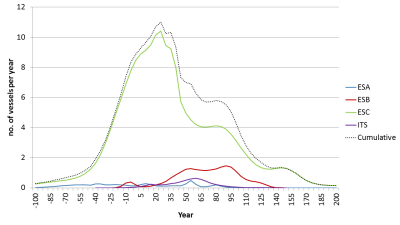
For Assos, the dominance of ESC is apparent from the latter half of the first century BCE until the second century CE, with other wares reaching the city in small numbers, particularly during the first century CE (Figure 7). Here, the arrival of ESB from the late first century BCE is noteworthy, and it apparently becomes an alternative to ESC, which it partially replaces particularly in the first and early second century CE. Assos, a polis going back at least to the fourth century BCE, was already heavily monumentalised in the Late Hellenistic period and flourished during the Roman Imperial period, as attested by the presence of big elaborate tombs and sarcophagi (Serdaroglu et al. 1990, 3; Arslan and Rheidt 2013). The importation of tableware reflects this clearly, although the decline in the second century CE is somewhat at odds. It must be remembered that later wares are found at the site as well, such as the Çandarlı wares, Late Roman C and African Red Slip Ware (Zelle 2004).
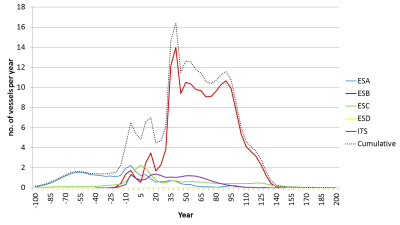
Ephesos (Figure 8) shows a pattern whereby imported tablewares arrive during the later first century BCE, most notably ESA and later ESC, with Italian imports remaining present during the first century CE, although by that time, ESB dominates the market. Cumulatively, these wares show a substantial increase during the late first century BCE and early Imperial period, although again in the second century they are under-represented, which cannot clearly be related to the urban economic development. Ephesos was already a city of importance during the Hellenistic period, but during Imperial times it became the capital of the province of Asia and saw a substantial expansion in urban area and presence of public buildings, particularly during the latter first and second centuries CE (Groh 2006). Ephesos was not only connected to the source of ESB production via geographical proximity, but also institutionally. Ephesos was a centre of an assize (see Appendix B), to which many cities situated in the Maeander Valley, such as Magnesia, Mastaura, and even more distant Brioula were assigned. One of the assigned cities was Tralleis, a city thought to be associated with ESB production, which may partially explain the predominance of ESB at Ephesos (Jones 1971, 78, 397; Dalla Rosa 2012, 264). Dio Chrysostom (Orationes, 34.15-17) noted that the court days, being held at an assize centre, attracted many traders and this in turn contributed to the city's prosperity. One could easily imagine that a juridical network, where Roman citizens had to move to a central place for juridical appeal to the governor once a year, may have coalesced or influenced the exchange patterns existing at the local level (Ligt 1993, 226).
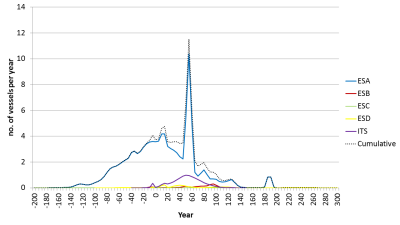
Tarsos (Figure 9) shows an early presence of local ESA, which remained the most important ware throughout the first two centuries CE, with a late rise caused by the later forms of ESA (Hayes' tarda series – Hayes 1985). But despite this, Italian imports became important in the later first century BCE and first century CE. To bring tableware to Tarsos from Italy, when Tarsos obviously had access to much closer sources, seems to defy the logic of proximity to source. ESB and ESD do not play an important role. Like Ephesos, Tarsos was a provincial capital from 66 BCE and an assize centre to which the cities of Rhosos and Aigai possibly were assigned (two cities located inside the presumed area of ESA production (Jones 1971, 203)). The ancient city of Tarsos may have flourished and grown in the first century CE, although archaeologically this cannot be ascertained as the modern city is situated right on top of the ancient site (Dio Chrysostom, Orationes, 40.11). That Tarsos became an important centre of linen weaving, and the city got further privileges under Augustus, may indicate its importance in long-distance trade, but historical sources do not give an obvious reason for the Italian imports.
From these three cities it is clear that cities in Asia Minor all had a different diachronic pattern in terms of tableware. In comparison, Sagalassos' production seems to peak relatively late, while the three coastal cities start acquiring red-slipped tablewares earlier. Of course, for many places tableware consumption did not start with the red-slipped tableware, but they already had access to black slipped wares in the Hellenistic and earlier periods. The consumption of red-slipped tablewares continues after the second century with later wares, such as African Red Slip Ware, Late Roman C and Late Roman D becoming important in the third to seventh centuries CE. But all these three cities show signs of relative prosperity and substantial tableware imports from producers in relative close proximity to each of them in the early Roman Imperial period. Sagalassos is flourishing in this period as well. This all gives further credence to John Lund's (2003) proposal in which he linked large flourishing urban centres with the heyday of tableware producers in their vicinity.
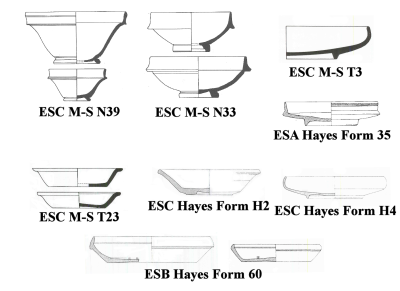
Of course, the question remains to what extent are the different diachronic patterns reflected in the vessels that were consumed at these three sites? In terms of morphology (see Figures 10-12; Tables 4-6), a mixed image arises. On the one hand, clear similarities can be found in all three cities, such as the relative popularity of cup-form types (such as ESC M-S N39, ITS Conspectus Form 22.1) or ESB Hayes Form 70 or ESA Hayes Form 22) and plates and dishes (such as ITS Conspectus Forms 18.2, 20.4; ESA Hayes Form 35 or ESB Hayes Form 60, ESC M-S Sa27; ESA Hayes Form 58). Yet the devil is in the detail and noticeable differences can be found. For example, plates with flat floors and carinated walls seem to be most commonly encountered at Ephesos, whereas at Tarsos and Assos they play a lesser role. At Tarsos, the mould-made bowl ESA Hayes Form 24 is most common, which is not found at the other cities in such numbers. The small hemispherical cups/bowls (ESB Form 29) are prevalent at Tarsos and Ephesos, but again not very common at Assos. Numerically, the later ESB forms are common at Ephesos, which are again dominated by dishes/plates (Forms 58, 60) over cups/small bowls (Forms 70, 71). This must reflect a shift to focus on fewer forms over the first century CE, where earlier a wider range of forms are deposited. At Assos, the earlier dominance of ESC cups/small bowls is added to in the later first century CE by the same ESB forms found at Ephesos. Here, the very broad typology by Meyer-Schlichtmann (1988) causes a fractured dataset, with many earlier forms only occurring once, although the dominance of cups is striking. At Tarsos, a similar focus on cups is found in ESA Form 48, although here the mould-made bowl Form 24 is an exception.
| Assos | |||||||||
|---|---|---|---|---|---|---|---|---|---|
| fabric and form | count | general shape | lower date | upper date | fabric and form | count | general shape | lower date | upper date |
| early first century CE | later first - second century CE | ||||||||
| ESA | ESB | ||||||||
| EAA35 | 4 | Plate | CE 40 | CE 70 | EAA60 | 12 | Plate/Dish | CE 50 | CE 150 |
| ESC | EAA70 | 9 | Cup | CE 50 | CE 125 | ||||
| M-SN39 | 181 | Cup | 75 BCE | CE 75 | EAA71 | 5 | Small bowl | CE 70 | CE 120 |
| M-SN33 | 138 | Small bowl | 75 BCE | CE 150 | ESC | ||||
| M-ST3 | 34 | Dish | 75 BCE | CE 125 | M-ST23 | 56 | Plate | CE 25 | CE 150 |
| M-SN13 | 30 | Small bowl | CE 1 | CE 50 | LRP2 | 25 | Dish | CE 100 | CE 200 |
| LRP4 | 12 | Plate/Dish | CE 175 | CE 300 | |||||
| ITS | |||||||||
| Consp20.4 | 7 | Plate | CE 25 | CE 96 | |||||
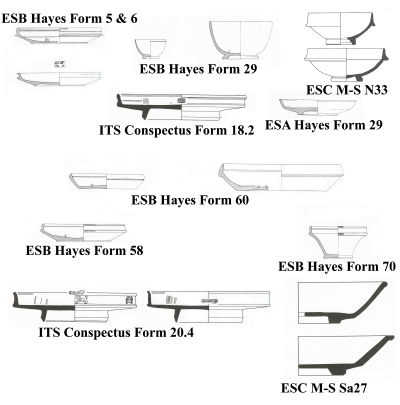
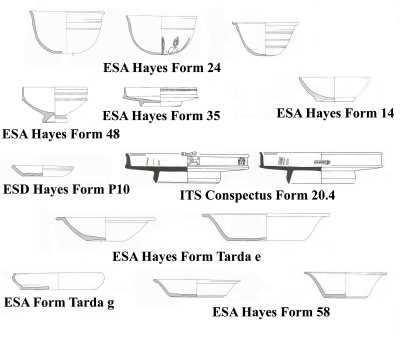
| fabric and form | count | general shape | lower date | upper date | fabric and form | count | general shape | lower date | upper date |
|---|---|---|---|---|---|---|---|---|---|
| early first century CE | later first-second century CE | ||||||||
| ESA | ESB | ||||||||
| EAA29 | 12 | Small plate | 30 BCE | CE 25 | EAA60 | 85 | Plate/Dish | CE 50 | CE 150 |
| EAA42 | 6 | Cup | 10 BCE | CE 30 | EAA70 | 47 | Cup | CE 50 | CE 125 |
| ESB | EAA58 | 45 | Plate/Dish | CE 50 | CE 125 | ||||
| EAA29 | 31 | Cup | 27 BCE | CE 150 | EAA80 | 25 | Bowl | CE 80 | CE 150 |
| EAA5 | 23 | Plate | CE 25 | CE 50 | EAA71 | 22 | Small bowl | CE 70 | CE 120 |
| EAA6 | 20 | Plate | CE 25 | CE 50 | ESC | ||||
| EAA7 | 16 | Plate | CE 25 | CE 50 | M-SSa27 | 7 | Bowl | CE 50 | CE 175 |
| EAA40 | 12 | Cup/Beaker | CE 1 | CE 25 | ITS | ||||
| ESC | Consp20.4 | 4 | Plate | CE 25 | CE 96 | ||||
| M-SN33 | 18 | Small bowl | 75 BCE | CE 150 | |||||
| ITS | |||||||||
| Consp18.2 | 5 | 10 BCE | CE 37 | ||||||
Although there are chronological differences in the Gaussian curves of the three cities, with the cumulative tableware curves peaking earlier at Assos and Tarsos than at Ephesos and Sagalassos, the morphological differences in the vessels mostly consumed at these sites in the late first century BCE and the first two centuries CE is noteworthy. Parallels for early SRSW forms can be found in other wares, yet it is striking that the most common forms at Sagalassos do not match those found in the three other cities. Plates or dishes with flat floors and carinated upstanding walls do not play an important role at Sagalassos (dish 1C170-1 being the only popular form bearing a hint of resemblance), while the dominance of container 1F150 is not reflected at all among the vessel forms in the other datasets (compare Table 2 with Tables 4-6). Although cups (1A100 and 1A130) are important forms at Sagalassos from the beginning of production, these shapes are not echoed at the three cities (compare Figure 4 with Figures 10-12). The only exception is cup/small bowl 1B150, which is paralleled in ESA Form 22 (Figure 13). This is a common form for the late second and first century BCE and found in some numbers at Ephesos (n=29) and Tarsos (n=21). Overall, the shapes at Sagalassos tend to be convex, while carinated shapes, such as most notably found in Italian sigillata and ESB, are not found.
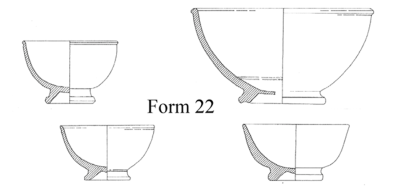
What these observations show is, on the one hand, a general popularity of red-slipped tablewares in Asia Minor from the first century BCE onward. This has been described previously as a 'tableware boom', which constituted a phase of fairly unique cultural integration under the early Roman Empire (Poblome and Zelle 2002). This boom roughly coincides with the prosperity of a large number of cities in Asia Minor. Yet it is also clear that there are differences in the chronology of this popularity, as this happens earlier at Assos and Tarsos than at Ephesos and Sagalassos. There is a noteworthy similarity in the popular forms in the three coastal cities (although differences should not be ignored), but the similarity with Sagalassos is limited. Both these observations tell us different things: purely in terms of production, there seems to be a cascade of tableware production at different places, starting from the East with ESA, continuing with ESD, ESC and ESB, while ITS becomes an important factor from the later first century BCE. SRSW became important in its own regional context from the first century CE onward (Bes 2015, 27-76). In terms of consumption, this cascade is especially reflected at Ephesos by the early presence and importance of imports from further away, while ESB, a more regional product for Ephesos, becomes dominant from the first century CE.
| fabric and form | count | general shape | lower date | upper date | fabric and form | count | general shape | lower date | upper date |
|---|---|---|---|---|---|---|---|---|---|
| first century CE | second century CE | ||||||||
| ESA | ESA | ||||||||
| EAA24 | 82 | Mould-made bowl | 100 BCE | CE 100 | EAA58 | 3 | Bowl | CE 100 | CE 150 |
| EAA48 | 77 | Cup | CE 40 | CE 70 | EAA57 | 3 | Plate | CE 100 | CE 150 |
| EAA35 | 8 | Plate | CE 40 | CE 70 | EAAtarda-g | 3 | Plate | CE 175 | CE 200 |
| EAA14 | 7 | Bowl | CE 1 | CE 25 | EAAtarda-e | 3 | Dish | CE 175 | CE 200 |
| EAA47 | 7 | Cup | CE 10 | CE 70 | EAAtarda-b | 2 | Dish | CE 175 | CE 200 |
| ESD | ESB | ||||||||
| EAAP10 | 3 | Dish | CE 1 | CE 75 | EAA71 | 3 | Small bowl | CE 70 | CE 120 |
| EAAP28 | 2 | Small bowl | CE 1 | CE 100 | ESD | ||||
| EAAP8 | 2 | Plate | CE 1 | CE 25 | EAAP11 | 2 | Bowl/Dish | CE 50 | CE 150 |
| ITS | |||||||||
| Consp20.4 | 2 | Plate | CE 25 | CE 96 | |||||
All this may explain the ware being consumed at a specific site, yet it says very little about the popularity of specific forms. For this, we first need to take into consideration the usage of these vessels, namely in dining. The banquet or the convivium typically took place in a purpose-built room, the triclinium, in which three couches were placed and where patron and guests would lie down. The participants would be offered individual servings, which explains the popularity of cups, smaller plates and bowls during the first two centuries CE (Pliny Ep. 2.6; Plutarch Mor. Quaest. Conv. 2.10.1; Martialis 3.60). This contrasts with later periods, when communal dining was accompanied by the popularity of larger communal vessels (Hudson 2010; Dunbabin 2003, 39-40; cf Hawthorne 1997). This partly explains the encountered general morphology, yet it cannot explain the specific morphological similarity and diversity of the tableware encountered in the four cities.
It seems likely that, given the scale of production encountered at Sagalassos and given the existence of contracts between potters and landowners, that the elite was involved in the production of tableware (Poblome and Brulet 2005, 30). Furthermore it has been argued that the ceramic tablewares discussed here are in essence mimicking or emulating more expensive tableware in glass, silver and gold, and the dining habits of the elite (skeuomorphism; Vickers 1999, 4-7). If true, this may lead to a more uniform 'fashion' of vessel morphology and indeed upon closer inspection, some parallels in silver (albeit rarely originating from the Roman East) and glass can be found for the more popular forms discussed here. For sake of simplicity, the glass typology by Clasina Isings (1957) is used here. For both mould-made bowl ESA Form 24 and mastos 1A130, both vessel-shapes already present in Late Hellenistic times, parallels in glass and silver can be pointed out (Fleming 1999, 8; Oliver and Luckner 1977, 78-85; Strong 1966, 108-9). For the small bowls with a collar or cut-out ridges, such as ESC Forms N33, N39 and ESB Form 70, an obvious glass parallel is found in Isings Form 69, while the treasure of the Villa Boscoreale (north-west of Pompeii) yields small cups or bowls on elaborate feet but with a similar collared/concave rim as well (Baratte 1986, 42-43; for examples of Isings 69, see Foy 2003, 83, 114, 118-19). This treasure also has vessels comparable to SRSW Forms 1C100, 1C170, 1B190-1 and a flat-based silver plate with convex walls similar to ESA Form tarda-g. Glass cylindrical dishes, such as Isings Form 22-23 and 48-49 are strongly echoed in plate ITS Conspectus Form 20.4 (Stern 2001, 89). Isings Form 80 is a glass bowl with outsplayed sides, which is reflected somewhat in ESA Form 58, tarda-e and early SRSW 1C100 dishes, while similar dishes in silver are also encountered in the Boscoreale treasure (Baratte 1986, 42-43). For the glass hemispherical cup Isings Form 81 contemporaneous links can be found with early and finer examples of the SRSW 1B150, while in essence, the form of the famous 'Morgan cup' (Harden 1988, 80-82, 270), of which plainer samples are known as well, is reflected in the SRSW 1A100. Three plain silver cups found at Tivoli (dating to the mid-first century BCE) with ring feet, convex walls and incurved rims are similar to SRSW 1B150 and 1B170 (Oliver and Luckner 1977, 106). Four dishes with ledge handles from the treasure in the House of Menander have been morphologically compared to SRSW forms 1B160-3 and 1C190-1 (Maiuri 1936, nos 44-47; Poblome 1999, 300-1; Painter 2001, 49; Allison 2006, 89, cat. no. 408).
Although some parallels for the popular shapes can be found in these other materials, the diversity does not seem indicative of a single 'fashion' or norm followed. Furthermore, the quantitative differences between cups, plates, dishes etc. in the four cities potentially indicate slight differences in habits of food consumption for which these vessels were used, although this requires further research at this point. In particular, the popularity of container 1F150 seems completely at odds with the other cities. Furthermore, the focus on more convex shapes and the continued popularity of the mastos (1A130) suggests that the tableware tradition of Sagalassos stays more rooted in Anatolian or Hellenistic traditions. The popularity of the mould-made bowl (ESA Form 24) at Tarsos also suggests continuity from the Hellenistic period. Yet all three cities, particularly at the Aegean coast, show a propensity towards carinated shapes (such as ITS Forms 18.2; 20.4; ESA Form 35 and to some degree ESB Form 5-6 and Form 58) and the collared cup (ESB Form 70 and ESC M-S Form N39). Not only is ITS imported to these sites, but the carinated shapes and collared cups in other wares share similarities with the Italian spectrum. Here it is noteworthy that the names of potter's stamps in ITS also appear on ESB, suggesting that some potters of ITS had subsidiary production centres in the Maeander Valley (e.g. C. SENTIUS; see Zabehlicky-Scheffenegger 1995, 226-28). It is difficult to say whether these morphological variations constituted active conscious choices related to local traditions and identity, but they were at the very least a passive component of it (Roth 2007). On the other hand, if the production at Sagalassos is related to the founding of Pisidian colonies, settled with veterans from Augustus' legions, this morphological distinctiveness indicates that norms for tableware found elsewhere did not dictate production. Here it must be noted that apart from newcomers, Pisidia already had several urban focal points that continued to exist and the colonies were founded alongside existing settlements.
All these reasons can explain in part the consumption patterns of tableware encountered at these sites. Dining practices, the attempt to emulate the elite, local traditions and identity, connectivity and trade, all influence to some degree the vessels being consumed at a site in a specific geographic, socio-cultural, political and economic context. This hints at the great underlying complexity of the consumption patterns described here. The use of large datasets allows us to analyse and compare data from disparate sources and bring this complex picture of the development and consumption of tableware in Asia Minor to the forefront. Here a tension-field between similarity and distinctiveness is found in the coastal cities, which can be linked to their relatively good connectivity via seaborne commerce, but even there, more local sources and, to some extent, fashions prevail.
Sagalassos in turn seems mostly to follow its own course in terms of tableware. Although much work is to be done on the cities and ceramics of Asia Minor, not to mention rural sites, this already seems to indicate an interplay between overall similarity, and some concept of universality, and regional distinctiveness, which is not surprising given the complex cultural make-up and regional variation in many aspects, from religion to political structures to geography. As already alluded to in the introduction, this fits the concepts of (proto-)globalisation. Globalisation often sees a re-orientation of consumption, for which classes of consumers are created with a common goal of acquiring goods to signal position and status. On the macro-scale level, this leads to a net growth in production and consumption. This is reflected in the boom in tableware observed in the Late Hellenistic and Roman Imperial periods and the rise of large specialised production centres. Similarly, the diversity observed in the tableware in different areas also fits with an increase of divergent consumers or the universalisation of the particular and the particularisation of the universal, to paraphrase Witcher (cf. Pitts and Versluys 2015, 17).
This article has revealed a rather complex pattern of tableware consumption at four cities in Asia Minor. These patterns are shaped on the one hand by larger processes to which all of Asia Minor was subjected, such as the incorporation into the Roman hegemony. This is reflected particularly at the coastal cities, where there is morphological similarity between local products and imports (e.g. ESB and ITS). At the same time other sources of tableware with divergent shapes are consumed as well. Analogous shapes can be found in silver, glass, and ceramic vessels. However, it must be admitted that there was not a simple copying of 'elite' vessels in ceramic 'non-elite' tableware for the entire spectrum of shapes. This underlines that complexity in tableware is not just presenting itself spatially and chronologically, but socially as well. The local-regional context clearly affects these patterns as well, as the start of production for Sagalassos demonstrates: the production coincided with Roman colonisation in the region of Pisidia (probably stimulating a need for sigillata-like tableware). This can be considered a global influence. At the same time, Sagalassos produces a distinct spectrum of shapes that show continuity with previous pottery traditions and 'non-conformity' with larger trends in tableware observed in ITS. This is possibly a local reaction to increasing global influences and/or it is part of the local identity. It is therefore essential to keep an eye on the pluriform and complex processes underlying consumption patterns of pottery. As a final remark, the focus of this article is on the wares with large supra-regional distribution. It shows that local or regional products could play a significant role (e.g. Sagalassos; see also Willet (2012, 59-143) for Boeotian cities and local production of tableware). To address this, Roman pottery studies, where they do not already do so, need to make more use of local and regional products, even though these are sometimes more difficult to date and interpret. These consumption patterns reflect the divergent reactions of the elite and non-elite to an increasing connected world.
Internet Archaeology is an open access journal based in the Department of Archaeology, University of York. Except where otherwise noted, content from this work may be used under the terms of the Creative Commons Attribution 3.0 (CC BY) Unported licence, which permits unrestricted use, distribution, and reproduction in any medium, provided that attribution to the author(s), the title of the work, the Internet Archaeology journal and the relevant URL/DOI are given.
Terms and Conditions | Legal Statements | Privacy Policy | Cookies Policy | Citing Internet Archaeology
Internet Archaeology content is preserved for the long term with the Archaeology Data Service. Help sustain and support open access publication by donating to our Open Access Archaeology Fund.